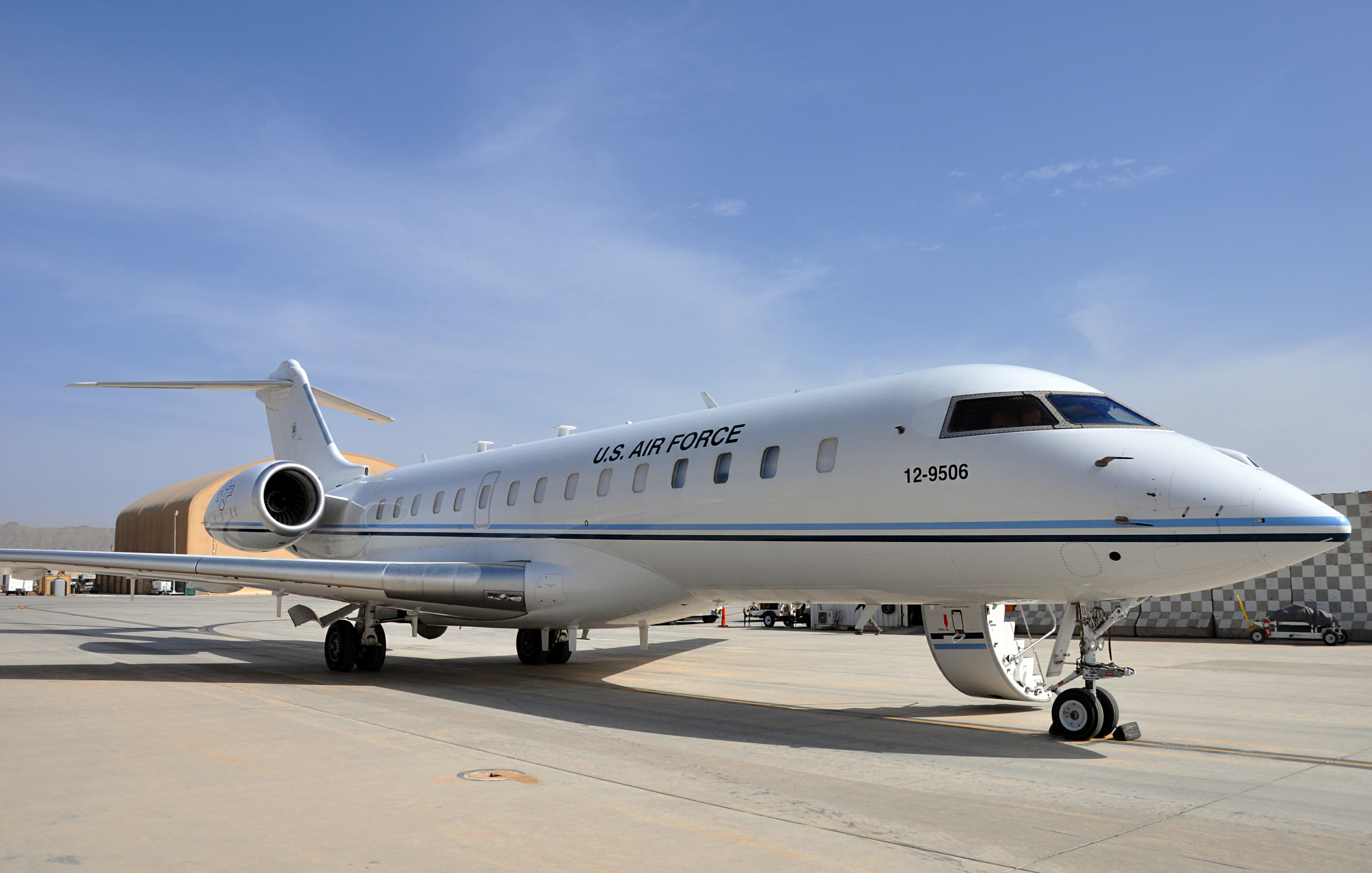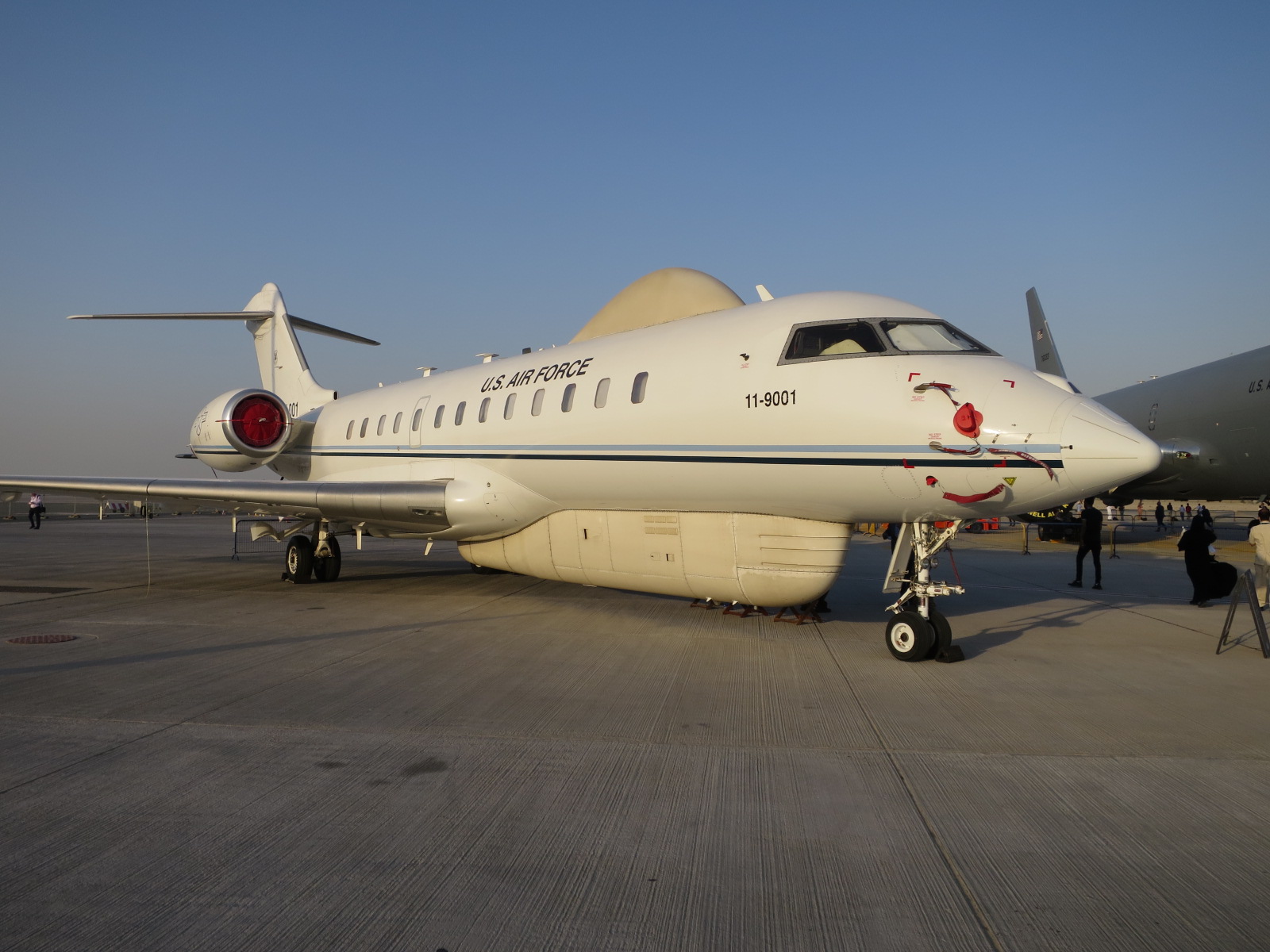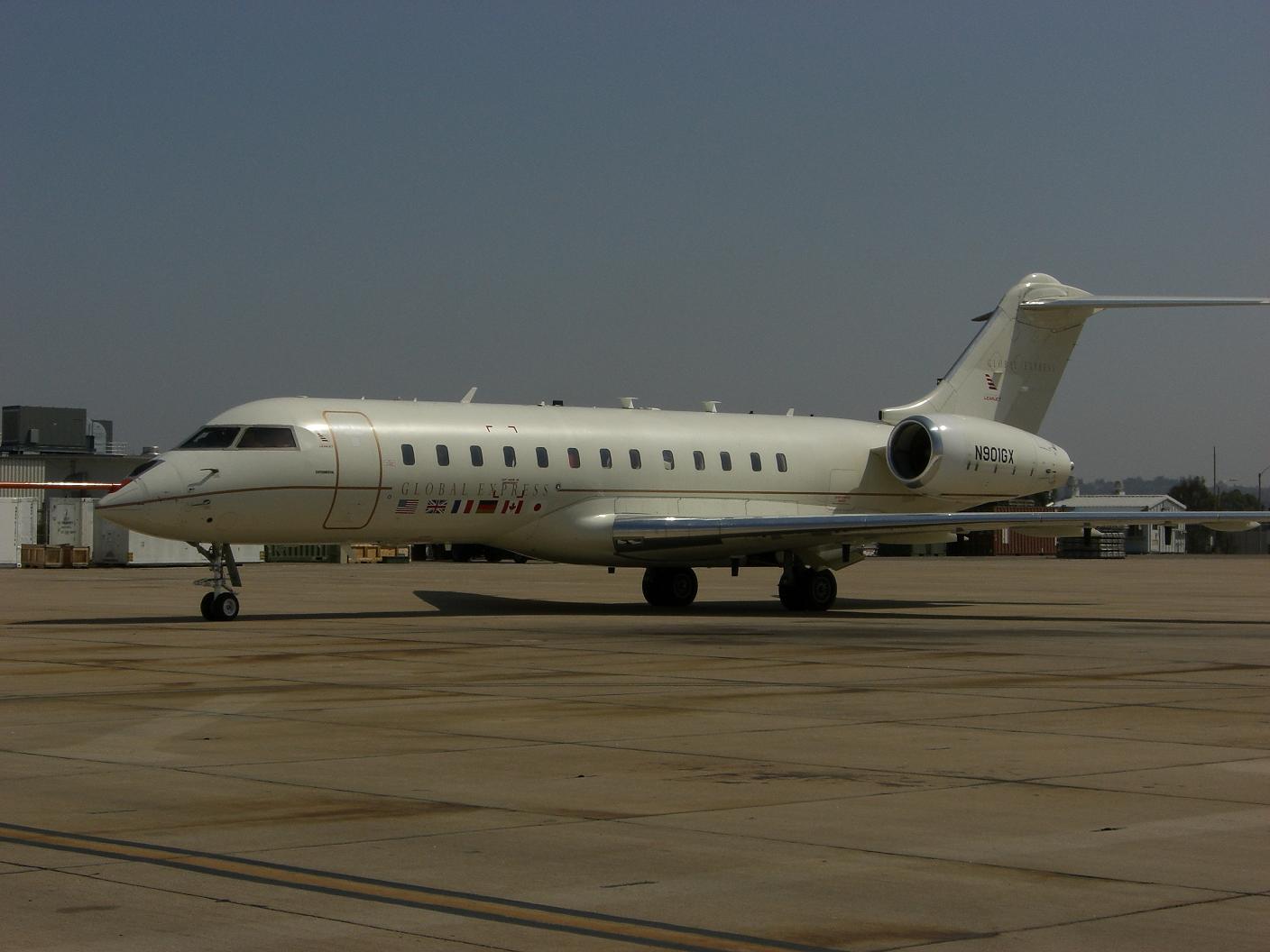|
Battlefield Airborne Communications Node (BACN)
The Battlefield Airborne Communications Node (BACN) is a United States Air Force (USAF) airborne communications relay and gateway system carried by the unmanned EQ-4B and the manned Bombardier E-11A aircraft. BACN enables real-time information flow across the battlespace between similar and dissimilar tactical data link and voice systems through relay, bridging, and data translation in line-of-sight and beyond-line-of-sight situations. Its ability to translate between dissimilar communications systems allows them to interoperate without modification. Because of its flexible deployment options and ability to operate at high altitudes, BACN can enable air and surface forces to overcome communications difficulties caused by mountains, other rough terrain, or distance. BACN provides critical information to all operational echelons and increases situational awareness by correlating tactical and operational air and ground pictures. For example, an Army unit on the ground currentl ... [...More Info...] [...Related Items...] OR: [Wikipedia] [Google] [Baidu] |
BACN Of The U
The Battlefield Airborne Communications Node (BACN) is a United States Air Force (USAF) airborne communications Repeater, relay and Gateway (telecommunications), gateway system carried by the unmanned Northrop Grumman RQ-4 Global Hawk, EQ-4B and the manned Bombardier Global 6000, Bombardier E-11A aircraft. BACN enables Real-time computing, real-time information flow across the battlespace between similar and dissimilar Tactical Data Links, tactical data link and voice systems through relay, bridging, and data translation in Line-of-sight propagation, line-of-sight and Non-line-of-sight propagation, beyond-line-of-sight situations. Its ability to translate between dissimilar communications systems allows them to interoperability, interoperate without modification. Because of its flexible Military deployment, deployment options and ability to operate at high altitudes, BACN can enable air and surface forces to overcome communications difficulties caused by mountains, other rough t ... [...More Info...] [...Related Items...] OR: [Wikipedia] [Google] [Baidu] |
2020 United States Air Force E-11A Crash
On 27 January 2020, a United States Air Force Bombardier Global Express E-11A aircraft crashed in Afghanistan's Dih Yak District, Ghazni Province. Two people on board were killed, who comprised the entire crew according to U.S. military sources. With the complete withdrawal of U.S. forces from Afghanistan in August 2021, this was the last acknowledged U.S. fatal aviation incident of the war in Afghanistan. Accident The aircraft crashed at 13:10 local time (08:40 UTC) in the Dih Yak District. Ghazni Province, Afghanistan. The crash site is south west of Kabul, and near the village of Sado Khelo. Voice of America stated that all five people on board were killed. The U.S. Department of Defense only confirmed two fatalities recovered at the crash site. Two Afghan locals died on the ground by impact of the crash. It was originally reported to be an aircraft of Ariana Afghan Airlines, but the airline later ruled out this possibility, saying all its flights had been accounted for ... [...More Info...] [...Related Items...] OR: [Wikipedia] [Google] [Baidu] |
Airborne Radio Relay
Airborne radio relay is a technique employing aircraft fitted with radio relay stations for the purpose of increasing the range, flexibility, or physical security of communications systems. The aircraft may be manned or unmanned aerial vehicles. Use in Vietnam One of the first uses of airborne radio relay was by the United States Army's 1st Cavalry Division in the Battle of Ia Drang during the Vietnam War, which employed the technique to improve communications with commanders at headquarters. The action of war had shifted to the borders of Laos and Cambodia, where the hilly terrain made the monetary and human cost of seizing and holding high ground, and airlifting and installing radio relay equipment prohibitive. In 1968, the Department of the Army provided four specially-equipped relay aircraft to the Division, which proved invaluable throughout the country, in particular, during the 1st Cavalry Division's relief of Khe Sanh in 1968. The use of airborne radio relay was a great su ... [...More Info...] [...Related Items...] OR: [Wikipedia] [Google] [Baidu] |
Global Information Grid
The Global Information Grid (GIG) is a network of information transmission and processing maintained by the United States Department of Defense. More descriptively, it is a worldwide network of information transmission, of associated processes, and of personnel serving to collect, process, safeguard, transmit, and manage this information. It is an all-encompassing communications project of the United States Department of Defense. The GIG makes this immediately available to military personnel, to those responsible for military politics, and for support personnel. It includes all infrastructure, bought or loaned, of communications, electronics, informatics (including software and databases), and security. It is the most visible manifestation of network-centric warfare. It is the combination of technology and human activity that enables warfighters to access information on demand. It is defined as a "globally interconnected, end-to-end set of information capabilities for collecting ... [...More Info...] [...Related Items...] OR: [Wikipedia] [Google] [Baidu] |
Air Force Materiel Command
Air Force Materiel Command (AFMC) is a major command (MAJCOM) of the United States Air Force (USAF). AFMC was created on July 1, 1992, through the amalgamation of the former Air Force Logistics Command (AFLC) and the former Air Force Systems Command (AFSC). AFMC is headquartered at Wright-Patterson Air Force Base in Dayton, Ohio. AFMC is one of nine Air Force Major Commands and has a workforce of approximately 80,000 military and civilian personnel. It is the Air Force's largest command in terms of funding and second in terms of personnel. AFMC's operating budget represents 31 percent of the total Air Force budget and AFMC employs more than 40 percent of the Air Force's total civilian workforce. The command conducts research, development, testing and evaluation, and provides the acquisition and life cycle management services and logistics support. The command develops, acquires and sustains the air power needed to defend the United States and its interests. This is accomplished ... [...More Info...] [...Related Items...] OR: [Wikipedia] [Google] [Baidu] |
Hanscom Afb
Hanscom Air Force Base (AFB) is a United States Air Force base located predominantly within Bedford, Massachusetts, with portions extending into the adjoining towns of Lincoln, Concord and Lexington. The facility is adjacent to Hanscom Field which provides general aviation and charter service. Hanscom AFB is the part of the Air Force Life Cycle Management Center, one of six centers under Air Force Materiel Command (AFMC). The Air Force Life Cycle Management Center is the single center responsible for total life cycle management of Air Force weapon systems and is headquartered at Wright-Patterson AFB, Ohio. The host unit at Hanscom is the 66th Air Base Group (66 ABG) assigned to AFMC. Overview A non-flying base, Hanscom Air Force Base is named after Laurence G. Hanscom (1906–1941), a pilot, aviation enthusiast, and State House reporter who was killed in a plane crash at Saugus, Massachusetts. Hanscom was a reporter for the Boston Globe, Worcester Telegram & Gazette and ... [...More Info...] [...Related Items...] OR: [Wikipedia] [Google] [Baidu] |
WB-57
The Martin B-57 Canberra is an American-built, twin-engined tactical bomber and reconnaissance aircraft that entered service with the United States Air Force (USAF) in 1953. The B-57 is a license-built version of the British English Electric Canberra, manufactured by the Glenn L. Martin Company. Initial Martin-built models were virtually identical to their British-built twinjet counterparts; Martin later modified the design to incorporate larger quantities of US-sourced components and produced the aircraft in several different variants. The B-57 Canberra holds the distinction of being the first jet bomber in U.S. service to drop bombs during combat. The Canberra was used extensively during the Vietnam War in a bombing capacity; dedicated versions of the type were also produced and served as high-altitude aerial reconnaissance platforms (the Martin RB-57D Canberra), and as electronic warfare aircraft. The B-57 Canberra was also sold to export customers abroad; further combat us ... [...More Info...] [...Related Items...] OR: [Wikipedia] [Google] [Baidu] |
928 Desktop
9 (nine) is the natural number following and preceding . Evolution of the Arabic digit In the beginning, various Indians wrote a digit 9 similar in shape to the modern closing question mark without the bottom dot. The Kshatrapa, Andhra and Gupta started curving the bottom vertical line coming up with a -look-alike. The Nagari continued the bottom stroke to make a circle and enclose the 3-look-alike, in much the same way that the sign @ encircles a lowercase ''a''. As time went on, the enclosing circle became bigger and its line continued beyond the circle downwards, as the 3-look-alike became smaller. Soon, all that was left of the 3-look-alike was a squiggle. The Arabs simply connected that squiggle to the downward stroke at the middle and subsequent European change was purely cosmetic. While the shape of the glyph for the digit 9 has an ascender in most modern typefaces, in typefaces with text figures the character usually has a descender, as, for example, in . The mod ... [...More Info...] [...Related Items...] OR: [Wikipedia] [Google] [Baidu] |
Electronic Systems Center
The Electronic Systems Center was a product center of Air Force Materiel Command (AFMC) headquartered at Hanscom Air Force Base, Massachusetts. Its mission was to develop and acquire command and control, communications, computer, and intelligence systems. ESC consisted of professional teams specializing in engineering, computer science, and business management. The teams supervised the design, development, testing, production, and deployment of command and control systems. Two of ESC's most well-known developments were the Boeing E-3 Sentry Airborne Warning and Control System (AWACS), developed in the 1970s, and the Joint Surveillance Target Attack Radar System (Joint STARS), developed in the 1980s. The Electronic Systems Center served into five decades as the Air Force's organization for developing and acquiring Command and Control (C2) systems. As of December 2004, ESC managed approximately two hundred programs ranging from secure communications systems to mission planning syst ... [...More Info...] [...Related Items...] OR: [Wikipedia] [Google] [Baidu] |
Air Force Command And Control Integration Center
The Air Force Command and Control Integration Center was an Air Combat Command field operating agency responsible for innovating, designing, developing, integrating, and sustaining command and control capabilities. It was a tenant unit at Langley Air Force Base, with several outlying support locations. The center was established in 1997 and inactivated in 2013. It had gone through numerous name and organizational changes, but maintained essentially the same mission throughout. From 2002 through 2010, it was aligned directly under the Air Staff. History The center was initially established at Langley Air Force Base, Virginia in August 1997 as the Air and Space Command and Control Agency. The agency included the two major field units that became the Air Force C2 Battlelab and the Air Force C2 Training and Innovation Group. The Tactical Air Forces Interoperability Group was a predecessor organization under Tactical Air Command. It was focused primarily on tactical intero ... [...More Info...] [...Related Items...] OR: [Wikipedia] [Google] [Baidu] |
BACN BD700
The Battlefield Airborne Communications Node (BACN) is a United States Air Force (USAF) airborne communications relay and gateway system carried by the unmanned EQ-4B and the manned Bombardier E-11A aircraft. BACN enables real-time information flow across the battlespace between similar and dissimilar tactical data link and voice systems through relay, bridging, and data translation in line-of-sight and beyond-line-of-sight situations. Its ability to translate between dissimilar communications systems allows them to interoperate without modification. Because of its flexible deployment options and ability to operate at high altitudes, BACN can enable air and surface forces to overcome communications difficulties caused by mountains, other rough terrain, or distance. BACN provides critical information to all operational echelons and increases situational awareness by correlating tactical and operational air and ground pictures. For example, an Army unit on the ground currentl ... [...More Info...] [...Related Items...] OR: [Wikipedia] [Google] [Baidu] |
Repeater
In telecommunications, a repeater is an electronic device that receives a signal and retransmits it. Repeaters are used to extend transmissions so that the signal can cover longer distances or be received on the other side of an obstruction. Some types of repeaters broadcast an identical signal, but alter its method of transmission, for example, on another frequency or baud rate. There are several different types of repeaters; a telephone repeater is an amplifier in a telephone line, an optical repeater is an optoelectronic circuit that amplifies the light beam in an optical fiber cable; and a radio repeater is a radio receiver and transmitter that retransmits a radio signal. A broadcast relay station is a repeater used in broadcast radio and television. Overview When an information-bearing signal passes through a communication channel, it is progressively degraded due to loss of power. For example, when a telephone call passes through a wire telephone line, some of the powe ... [...More Info...] [...Related Items...] OR: [Wikipedia] [Google] [Baidu] |






